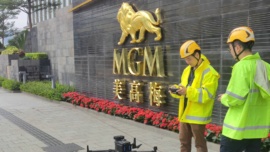
Zhang Ruopiao
Executive Council Member
Macau Institute for Corporate Social Responsibility in Greater China (MICSRGC)
Recent estimates indicate that species are vanishing at a rate of at least 1,000 times faster than they would without human intervention. Since 1970, populations of mammals, birds, fish, reptiles, amphibians as well as a wide range of species have reduced significantly. Scientists and conservationists refer to the current era of mass extinction as the ‘sixth mass extinction’, and some have even referred to today’s decline in biodiversity as ‘biological destruction’. Biodiversity not only contributes to ecosystem productivity but also to food security and human adaptation to climate change. Despite the significance of biodiversity, rapid global socioeconomic development has put the environment under increasing strain.
Corporate social responsibility (CSR) is commonly considered to outline a firm’s responsibilities not only for the economic consequences of their activities but also the social and environmental ramifications. This is referred to as a ‘triple bottom line approach’, as it takes into account the economic, social and environmental impacts of corporate operations. Thus, social and environmental reporting is deemed an important way to alleviate environmental crises caused by human interference. Scholars in the field of CSR have put forward the concept of ‘biodiversity and extinction accounting’ to better understand the connection between biodiversity and ecosystem services, economic activities and human well-being. The Global Reporting Initiative (GRI) has a separate section, GRI 304, dedicated to assisting businesses, governments and other organisations in understanding and communicating their impacts on biodiversity. Specifically, GRI 304 encourages organisations to report operational sites owned, leased, managed in or adjacent to protected areas and areas of high biodiversity value outside protected areas; the significant impacts of activities, products and services on biodiversity; habitats protected or restored; and IUCN’s (International Unit for Conservation of Nature) Red List species and national conservation list species with habitats in areas affected by operations.

In order to increase the specificity and effectiveness of the biodiversity and extinction disclosure framework, a revolutionary extinction accounting framework was developed by scholars to allow companies to disclose their impact on species and efforts undertaken to prevent extinction. Professors Jill Atkins (University of Sheffield, UK) and Warren Maroun (University of Witwatersrand, South Africa) have proposed an outline of the extinction accounting framework which describes a six-element process incorporating the following: a description of the extinction risk and the diverse reasons for wanting to address this risk; reporting the actions the company takes and plans to take to reduce extinction risk; complement action-focused reporting (including partnerships) formed to combat extinction; evaluation of extinction prevention initiatives; an audit of affected species/populations/biomes; and account of the progress. The extinction accounting paradigm may easily include an integrated capital report and should assist organisations to demonstrate how they manage ‘natural capital’ and prevent extinctions in the areas in which they operate.
Biodiversity and extinction accounting also provides insights for practical applications in local areas. For example, despite the fact that Macau is densely populated and highly urbanized, it nonetheless has a diverse range of wildlife as well as many wetlands with high ecological value. Researchers commented that the ecosystem of Macau is relatively fragmented and the endemic species native to Macau are facing persecution from urban development and pollution. The current efforts toward biodiversity conservation and extinction prevention in Macau is ad-hoc and problem-oriented with limited biodiversity and extinction disclosure by the government available to the public. Thus, a set of disclosure content and initiatives could be introduced to take care of the local ecosystem, species and genetic diversity. It is recommended that businesses, NGOs and governments explore the use of biodiversity and extinction accounting as a proactive means of mitigating the extinction of species and promoting biodiversity using a solid base of evidence.
It is generally believed that CSR reporting has the potential to drive positive change, as it is a communicative practice that may lead to social betterment. As the infinite cost of humankind’s unbounded claims on nature reaches irreversible highs, now is the time for bold collective action. This article argues that it is critical to establish a closer link between proactive species extinction prevention and our global capitalist system before it is too late. The loss of biodiversity will eventually bring an unparalleled catastrophe to mankind. Therefore, accounting for biodiversity is a prerequisite for long-term sustainable development. By emphasising the costs of biodiversity loss, the biodiversity and extinction accounting model can build a preliminary argument for preventing species extinction and ecological collapse, and using this to motivate more extensive investigation and reporting on species extinction. Hopefully, this article will inspire more collective efforts from businesses and various types of organisations to identify species loss and report their unrelenting efforts to prevent extinction.
In partnership with:

























